Determining the highest and best use - by David Kirk
The dramatic changes in a vibrant labor force are impacting just as dramatically the built environment. For any development, investment or speculation, determining the highest and best use (H&B) is first and the ongoing analysis. The appraisal process describes a 3 or 4 step process. Stewardship of the built environment includes the discipline and informs departures, exceptions and the blinking traffic lights. By the numbers: Physically possible, legally permissible, financially feasible. The fourth is a reconciliation of the first three and called variously the most profitable or highest and best use. Remembering that commercial property is an economic derivative, such changes in slicing and dicing the economy is basic.
The trends in property occupancy, rent or income and condition are measurable indicators. The trends in permits and construction are also measurable indicators. Investment activity is also defining. With this data, H&B gets a head start and a weather or whether report. Every property is unique and H&B is uniquely applicable to specific properties.
Physically possible does deal with soil bearing capacity, property dimensions, and access and services. Capacity and limits to physically possibility. This step can be expanded to include hypothetical and other what if’s. This information is often publicly available. Some requires professional testing and engineering such as soils and utilities. Sometimes legal research for title or encroachments.
Legally permissible deals with any land use restrictions. Most commonly local building codes and zoning ordinances. With climate change, state land use building codes are anticipating local ordinances. And with accelerating technologies in materials, operations, construction, resilience and climate change, best practices are leading the changes in what is permissible. What was once off the shelf has become significantly demanding research and interdisciplinary professional guidance. Noncompliance is trickier today. Additionally, the possibility and probability of exceptions which can be apparent in most recent and relevant permit activity.
Financially feasible has shortcuts. Quick and dirty proformas informed by market intelligence and development expertise. With the turbulence in capital markets and uncertainty rippling from Fed rate dynamics, most new development is highly speculative in spite of strong economic fundamentals. Because this rate run up will soon stop sometime! Hypothetical assumptions are speculative. Preparedness requires H&B.
Finally reconciliation. The final or fourth step in H&B is most profitable. H&B is an iterative process and stepping to the final conclusion is skipping notoriously to go. Intuition has always contributed to commercial property decisions. Particularly when economic conditions are flagrantly demonstrated.
Value add was more superficially popularized in the commercial property lexicon, characterizing risk and enterprise and rewards. H&B justifies and requires deeper dive into feasibility and funding. Already apparent in new construction and permits, change of use is such a broad array of opportunities in commercial property that a sound bite or label is misleading.
H&B has always been a dynamic of the built environment. Often in the leading edge, the frontier. Like technology, all speeds are variable for markets and unique to properties within the specific local markets. Remember the retail revolution. Amazon fulfillment centers and demolition. Remember flex space evolution. Mill buildings and adaptive reuse. And mixed use. All initially frontiers, somewhat speculative. Risky. The Boston market has a handful of major projects under construction, all mixed use with uses and the mix changing even while the steel is rising. All are in the range of $1 billion and one million s/f. Smaller new projects and adaptive reuse abound. The capital stack has adapted to the risks. Traditional capital sources are adjusting as well, more slowly. Major sponsors are stepping into the risk capital category. Data for underwriting the H&B is growing. Misleading in careless aggregations.
New Years are upon us. Use and apply your H&B disciplines wisely.
Happy Holidays and best for our years ahead.
David Kirk is founder, chief executive officer of Kirk & Co., Boston, Mass.
Boyle of Chozick Realty negotiates $7.95m sale of 66-unit property







